
Within the Midwest, the cities of Minneapolis and Saint Paul, Minnesota exemplify some of the most iconic regional takes on 19th and 20th century architectural and design movements. From the Beaux-Arts grandeur of the Cathedral of Saint Paul and the Art Deco stylings of the Foshay Tower, to more recent works like Frank Gehry’s stainless steel Weisman Art Museum and Jean Nouvel’s contemporary Guthrie Theater re-build, both skylines are peppered with structures that continue to push the form. This fall, a new exhibit at the Mill City Museum—housed in the ruins of a 19th century flour mill—will reflect on the perhaps unfamiliar history of three architects and builders who helped shape the Twin Cities of today.
“The Builders: Shaping Minnesota’s Architectural Landscape on the Color Line,” was created by the African American Interpretive Center of Minnesota and opened early August 2019 with a program featuring the organization’s Executive Director and Curator, JoJo Bell, and Co-curator and Research Assistant, Acoma Gaither. The exhibit will celebrate the life and work of three Black Minnesotans who impacted the architecture and design of Saint Paul and Minneapolis, according to the AAICMN.
“What we wanted to do was celebrate their accomplishments and talk about some of these social and racial issues they were facing as they were being professional in the Twin Cities at the time,” Bell said before the opening. “The inspiration was: how can we tell a story that people may or may not be familiar with, and then what are some other angles of that story?”
Inspired by his imagination and skill when creating structures like the “ice palaces” at the Saint Paul Winter Carnival, and the Mediterranean Revival-inspired Highland Park Water Tower, the AAICMN chose to highlight Clarence W. Wigington, who was a lead architect on more than 90 Saint Paul projects and the nation’s first African American municipal architect, according to the Minnesota Historical Society.
“The Builders” also features Casiville Bullard, a renowned brick layer and stone mason, who also worked on the Highland Park Water Tower and several other iconic regional projects like the Cathedral of Saint Paul and the Foshay Tower, which many consider to be Minnesota’s first original skyscraper. Bullard’s own home, finished in the early 1900s is listed in the National Register of Historic Places.
The exhibit also highlights William Hazel, who’s successful career as a stained-glass artist and architect on the East Coast and in Minnesota predates his status as a celebrated civil rights influencer in the area.
To re-construct historical accounts for each distinguished “builder,” the AAICMN gathered resources like blueprints, renderings, photographs, and drawings of some of their finest works. A 3D model of the ice sculpture Wigington created for the Winter Carnival in 1942 was even fabricated for the exhibit by Minneapolis-based architecture and design firm LSE Architects Inc. The structures featured in “The Builders” are integral parts of Minnesota’s architectural history that are relevant in city society today. The exhibit is intended to prompt visitors to re-consider the buildings they interact with daily, and also examine the social and racial implications tied to the time period they were built in, according to Bell.
“There are two things that I’m hoping people will take away from this. One is just to kind of re-explore the space from new eyes,” Bell said. “The second thing we want to take away is bringing to light this kind of theme that historians like to look at which is life on the color line; meaning ‘what were these written or unwritten barriers that they had to face as they were coming into their own.’”
Since its establishment in 2016, the AAICMN has been a non-profit organization dedicated to sharing the history of Black Minnesotans through exhibits and events, such as the 2017 panel discussion “WWI: The Black Experience,” and the exhibit “Minnesota’s Black Past in Photographs.”
To create the historical snapshot of “The Builders,” which closes late October 2019, the AAICMN also partnered with LSE Architects, Five x Five Art Consultants, Color Space Art and Imaging, Mill City Museum, and Daniel Bergin, TPT. Five x Five Art Consultants is a widely-renowned supporter and developer of Minnesota’s creative community, as is LSE Architects, whose designs are seen throughout the region’s educational, commercial, and hospitality sectors, among others. The Mill City Museum, which will host “The Builders” until October 27th, is a Minnesota Historical Society Museum, and a celebrated architectural and historic landmark of its own.
Text: R. Collins | GLBD writer






